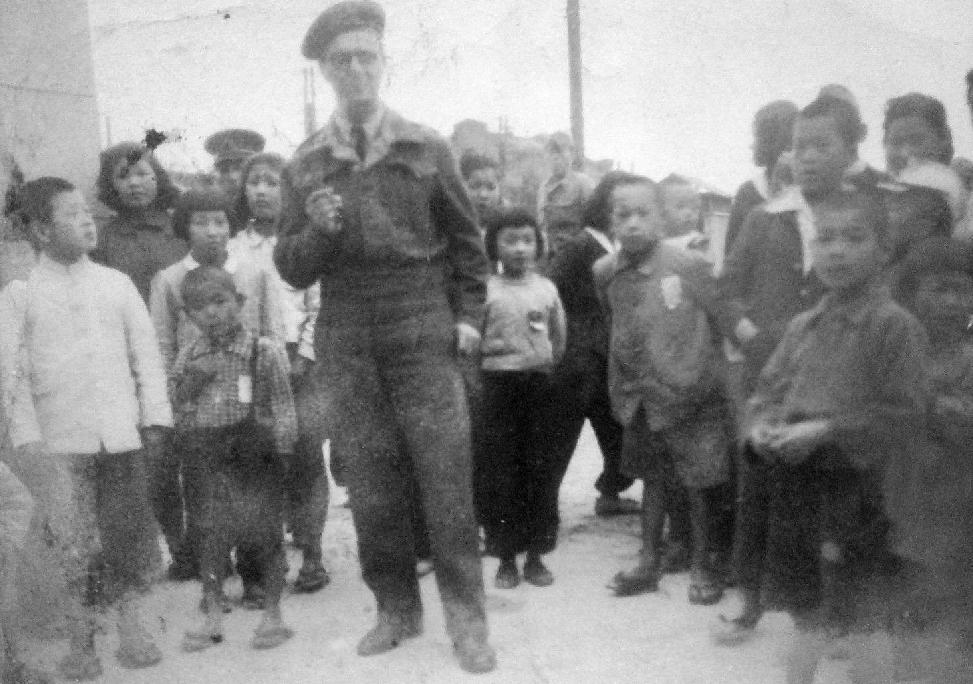
Japanese Surremder: Allied Occupation Authority--British Commonwealth Occupation Force (1945-52)

Figure 1.--The World War II occupation of Japan was orimarily conducted by the United States through the SCAP. . There was a small British Commonwealth Occupation Force (BCOF). The ustralians played a major role. Here we see a an unidentified member of the BCOF with some Japanese children.
|
|
The Allied occupation of Japan was different than the occupation of Germany. United States was the principal occupation power and provided most of the occupation forces. President Harry Truman on VJ-Day appointed General Douglas MacArthur as Supreme Commander for the Allied Powers (SCAP) (August 14, 1945). He was tasked with overseeing the occupation. The Allies (not including the Soviets) during the War planned to partition Japan for the purposes of occupation. This is what occurred in Germany. With VJ Day, SCAP was given direct control over the main Home Islands ( Hokkaido, Honshu, Kyushu, and Shikoku) and the immediately surrounding islands. SCAP meaning Gen. MacArthur was not ordered to consult wuth the Allies. And the General showed during the War that unlike Gen. Eisenhower, he was not a coalition builder. Mac Arthur made the major decesions on his own, often without consulting Washington, let alone London and Canberra. The Allies did participate in the military occupation, but had virtually no voice in occupation policies. Allied participation in the occupation was the British Commonwealth Occupation Force (BCOF). They were not involved in the initial American landing force (September 1945). Planning for BCOF participation in the Allied occupation of Japan began after VJ Day, but the details were not agreed for a few months (January 31, 1946). The main body of the 45,000 trops BCOF involved arrived a month later. The BCOF force included troops from Australia, Britain, India, and New Zealand. The BCOF was assigned responsibility for the western prefectures of Shimani, Yamaguchi, Tottori, Okayama, Hiroshima, and Shikoku Island. The BCOF headquarters were located at Kure. Throughout its existence BCOF was always commanded by an Australian officer. The task of conducting the occupation military government over Japan was conducted by the United States SCAP. The primary assignment given to the BCOF was to enforce the terms of Japan's unconditional surrender. The BCOF in is area of responsibility maintained military control and supervised the demilitarisation and disposal of the remnants of Japan's war-making capacity. There were military supplies and equipment beverywhere. BCOF personnel located and secured military installations and supply stores. The intelligence sections investigate identified Japanese military supply dumps. Military equipment and amunition were destroyed or dumped at sea. Some of the material was either retained by the BCOF or returned to the Japanese for domestic security purposes or conversion to civilian use. This was conducted by Japanese civilians under BCOF supervision. The BCOF in its area conducted patrols and road reconnaissances as part of BCOF's surveillance operations.
The task of phyically demilitarising Japan was largely achieved (by the end of 1946). Thus the role of the occupation forces changed. Guard duties and training becoming the central focus. The BCOF countries with no real role in the occpation, quickly lost interest. India achieved independemce. Britain adjuating to diminishing resources foced in Europe. Australia which had severely threatened carried the bulk of the Commonealth War in the Pacific carried on. The Indians after independence convinced themselves that when the Japanese tried to invade, it was the British they were attacking not India. After 2 years all but the Australian troops withdrew. The Commonwealth cointinued to be represented solely by Australians. North Korea invaded the South (1950). This changed the complexion of the occupation in Japan. The BCOF was dismantled (1952). The limited responsibilities in Japan were handed over to the British Commonwealth Forces Korea. A small forece remained to serve in the Korean War. BCOF was terminated when the Japanese Peace Treaty came into effect (April 28, 1952). This was nearly a decade before the Western Allies ended the occpation of West Germany.
Sources
Wood. James. James Wood, The forgotten force: the Australian military contribution to the occupation of Japan 1945–1952 (Allen and Unwin: 1998)
CIH -- WW II

Navigate the CIH World War II Section:
[Return to Main Japanese World War II occupation page]
[Return to Main Japanese World War II aftermath page]
[Biographies]
[Campaigns]
[Children]
[Countries]
[Deciding factors]
[Diplomacy]
[Geo-political crisis]
[Economics]
[Home front]
[Intelligence]
[POWs]
[Resistance]
[Race]
[Refugees]
[Technology]
[Totalitarian powers]
[Bibliographies]
[Contributions]
[FAQs]
[Images]
[Links]
[Registration]
[Tools]
[Return to Main World War II page]
[Return to Main war essay page]
[Return to CIH Home page]
Created: 11:09 PM 4/9/2019
Last updated: 11:09 PM 4/9/2019



